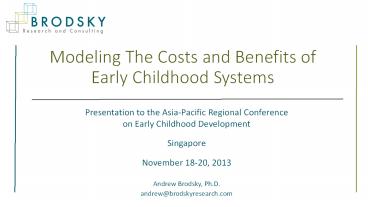Modeling The Costs and Benefits of Early Childhood Systems - PowerPoint PPT Presentation
Title:
Modeling The Costs and Benefits of Early Childhood Systems
Description:
Modeling The Costs and Benefits of Early Childhood ... socioemotional development (e.g ... is $19,076 per child Most ECD resources go to early ... – PowerPoint PPT presentation
Number of Views:211
Avg rating:3.0/5.0
Title: Modeling The Costs and Benefits of Early Childhood Systems
1
Modeling The Costs and Benefits of Early
Childhood Systems
- Presentation to the Asia-Pacific Regional
Conference - on Early Childhood Development
- Singapore
- November 18-20, 2013
- Andrew Brodsky, Ph.D.
- andrew_at_brodskyresearch.com
2
Types of Cost Analysis
- Simple cost analysis (from perspective of system
or agency) - Cost-effectiveness analysis (per-child costs to
achieve a particular outcome) - Cost-benefit analysis (requires quantifying
benefits in monetary figures) - (Karoly et al., 2001)
3
Theoretical Framework and Research Literature
- Developmental literature on key years for brain,
socioemotional development (e.g., Shonkoff and
Phillips, 2000) - Classic preschool longitudinal studies
(Abecedarian, High Scope/Perry, Chicago) - Recent research in developed and LAMI countries
on ECD interventions - meta-analyses show effect
size of .3 - .4 (Engle et. al, 2007, 2011) - Conceptions of ECD as intrinsic or instrumental
(Britto et al, 2013) - Economics literature (Heckman)
4
Heckman Curve
5
Long-Term Benefits of ECD
- Reduced participation in special education
- Higher secondary graduation rates
- Reduced participation in criminal justice system
- Fewer repeated grades
- Higher income in adulthood
6
Cost-Benefit Model Methodology
- Determine Goals and Scope of Project
- Purpose, stakeholders, scope, data
- Research Review and Data Collection
- Child characteristics, funding, costs, current
status, cost-benefit parameters - Conduct cost-effectiveness analysis (if
necessary) - Derive Formulas to Estimate Cost-Benefit
Parameters - Adjust for program alignment, local costs,
demographics, quality
7
Amount of ECD Funding Across System
- Absolute amount seems large (4 billion for New
York) - ECD investment is very small compared to K-12
system - NY
- ECD investment is 2,754 per child
- K-12 investment is 19,076 per child
- Most ECD resources go to early learning (in New
York, 78 of EC system)
8
Return On Investment (ROI) For Increased
Enrollment vs. Improved Quality (Colorado)
Return Type Return Per Dollar Invested (USD) Return Per Dollar Invested (USD) Return Per Dollar Invested (USD)
Return Type Current System Increased Enrollment Improved Quality
Overall 8.79
Child Care Industry 1.13
Future Income 1.56
Repeated Grades 0.08
Special Education 0.48
Graduation Rates 0.05
Child Welfare 0.85
Criminal Justice 0.39
Reduced Welfare 1.73
Taxes 0.26
9
Return On Investment (ROI) For Increased
Enrollment vs. Improved Quality (Colorado)
Return Type Return Per Dollar Invested (USD) Return Per Dollar Invested (USD) Return Per Dollar Invested (USD)
Return Type Current System Increased Enrollment Improved Quality
Overall 8.79 6.50
Child Care Industry 1.13 0.86
Future Income 1.56 1.19
Repeated Grades 0.08 0.06
Special Education 0.48 0.37
Graduation Rates 0.05 1.72
Child Welfare 0.85 0.04
Criminal Justice 0.39 0.65
Reduced Welfare 1.73 0.30
Taxes 0.26 1.32
10
Return On Investment (ROI) For Increased
Enrollment vs. Improved Quality (Colorado)
Return Type Return Per Dollar Invested (USD) Return Per Dollar Invested (USD) Return Per Dollar Invested (USD)
Return Type Current System Increased Enrollment Improved Quality
Overall 8.79 6.50 13.82
Child Care Industry 1.13 0.86 1.98
Future Income 1.56 1.19 2.49
Repeated Grades 0.08 0.06 0.12
Special Education 0.48 0.37 0.76
Graduation Rates 0.05 1.72 3.59
Child Welfare 0.85 0.04 0.08
Criminal Justice 0.39 0.65 1.35
Reduced Welfare 1.73 0.30 0.62
Taxes 0.26 1.32 2.75
11
Time To Break-Even for Preschool Investment
12
Commonalities of LAMI and Wealthy Countries
- ECD in LAMI nations has similar goals to Head
Start (Britto and Gilliam, 2008) - Many goals of ECD are universal (such as
Millennium Development Goals, economic growth, or
school readiness) - Attention to systemic or holistic approach
- Undergirded by developmental literature
13
Issues Specific to LAMI Countries
- How is Quality Defined?
- High-income countries safety, teacher-child
interactions, content knowledge (Britto et al.,
2011) - LAMI countries feeding and care, survival
issues, health service provider training,
infrastructure development, attention to physical
growth - Sensitivity to Local Contexts
- Great diversity within LAMI countries
- Metrics of success should be tied to local
context - Balance between local and universal sociocultural
values
14
Challenges and Opportunities in LAMI Countries
- Challenges
- Data collection/evaluation and monitoring systems
- Research base is less developed
- Sociocultural issues
- Trust!
- Opportunities
- Children with greatest needs show greatest
benefits - Need for ECD research in developing world
- Increasing attention to evidence-based
policymaking
15
Recommendations
- Use Holistic or Systemic Approach
- Involve a Wide Range of Stakeholders
- Outcome Metrics Should Reflect Both Universal
Goals and Local Culture - Adjust Parameters To Fit Local Context
- Develop Comprehensive Communication and Outreach
Strategy
16
Questions?
- Contact Info
- Andrew Brodsky
- andrew_at_brodskyresearch.com
- Website/blog www.brodskyresearch.com































